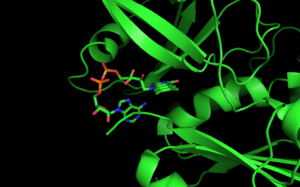Ferredoxin NADP+ Reductase
From Proteopedia
(Difference between revisions)
(Undo revision 2404046 by Rebecca Truitt (Talk)) |
|||
| Line 11: | Line 11: | ||
== Anaerobic Function == | == Anaerobic Function == | ||
| - | In many facultatively anaerobic bacteria, this protein acts as an oxygen sensor modifying gene expression that adapts the cell to anaerobic growth. The activity of FNR regulates the cells ability to metabolize aerobically or anaerobically so that when oxygen is abundant, FNR is destabilized and converted into an inactive form. | + | In many facultatively anaerobic bacteria, this protein acts as an oxygen sensor modifying gene expression that adapts the cell to anaerobic growth. The activity of FNR regulates the cells ability to metabolize aerobically or anaerobically so that when oxygen is abundant, FNR is destabilized and converted into an inactive form. The protein is activated when there are low oxygen tensions. This function is known as transcriptional sensor-regulation. The predominant pathway in which this regulation occurs is through binding or oxidation-reduction of oxygen in the iron sulfur center, in which the iron serves as the initiating cofactor that interacts with the oxygen when it is abundant. This is a reversibly constitutive regulation pathway. |
| - | Although facultative anaerobes prefer to use molecular oxygen as the terminal electron acceptor due the high reduction potential, low oxygen stress is able to induce the bacteria to use FNR instead. The transformation involves other proteins such as the sensor regulator system ArcAB, however these regulators are affected by other intermediates. FNR combines the functions of both a sensor and a regulator. | + | Although facultative anaerobes prefer to use molecular oxygen as the terminal electron acceptor due the high reduction potential, low oxygen stress is able to induce the bacteria to use FNR instead. The transformation involves other proteins such as the sensor regulator system ArcAB, however these regulators are affected by other intermediates. FNR combines the functions of both a sensor and a regulator. |
== Other Functions== | == Other Functions== | ||
| Line 26: | Line 26: | ||
== Structural highlights == | == Structural highlights == | ||
| - | In its active form, the protein is a <scene name='69/699901/Dimeric_fnr/1'>dimer</scene> and contains a [4Fe-4S]<sup>+2</sup> cluster. When inactive, the protein is monomeric and containts a [3Fe-4S]<sup>+2</sup> cluster. FNR in its <scene name='69/699901/Monomeric_fnr/1'>monomer</scene> form can be seen here, with bound NADP and FAD | + | In its active form, the protein is a <scene name='69/699901/Dimeric_fnr/1'>dimer</scene> and contains a [4Fe-4S]<sup>+2</sup> cluster. When inactive, the protein is monomeric and containts a [3Fe-4S]<sup>+2</sup> cluster. FNR in its <scene name='69/699901/Monomeric_fnr/1'>monomer</scene> form can be seen here, with bound NADP and FAD |
== References == | == References == | ||
| - | <references/> | + | <references/>[http://en.wikipedia.org/wiki/Ferredoxin—NADP(%2B)_reductase] |
| - | + | <references/>http://en.wikipedia.org/wiki/Oxidoreductase | |
| + | <references/>[flavin adenine dinucleotide][http://en.wikipedia.org/wiki/Flavin_adenine_dinucleotide] | ||
| + | <references/><ref>PMID:23382856</ref> | ||
<references/>Constantinidou, Chrystala, Jon L. Hobman, Lesley Griffiths, Mala D. Patel, Charles W. Penn, Jeffrey A. Cole, and Tim W. Overton. “A Reassessment of the FNR Regulon and Transcriptomic Analysis of the Effects of Nitrate, Nitrite, NarXL, and NarQP as Escherichia Coli K12 Adapts from Aerobic to Anaerobic Growth.” Journal of Biological Chemistry 281, no. 8 (February 24, 2006): 4802–15. <ref>doi:10.1074/jbc.M512312200.<ref> | <references/>Constantinidou, Chrystala, Jon L. Hobman, Lesley Griffiths, Mala D. Patel, Charles W. Penn, Jeffrey A. Cole, and Tim W. Overton. “A Reassessment of the FNR Regulon and Transcriptomic Analysis of the Effects of Nitrate, Nitrite, NarXL, and NarQP as Escherichia Coli K12 Adapts from Aerobic to Anaerobic Growth.” Journal of Biological Chemistry 281, no. 8 (February 24, 2006): 4802–15. <ref>doi:10.1074/jbc.M512312200.<ref> | ||
<references/>Tolla, Dean A., and Michael A. Savageau. “Phenotypic Repertoire of the FNR Regulatory Network in Escherichia Coli.” Molecular Microbiology 79, no. 1 (January 2011): 149–65. <ref>doi:10.1111/j.1365-2958.2010.07437.x.<ref> | <references/>Tolla, Dean A., and Michael A. Savageau. “Phenotypic Repertoire of the FNR Regulatory Network in Escherichia Coli.” Molecular Microbiology 79, no. 1 (January 2011): 149–65. <ref>doi:10.1111/j.1365-2958.2010.07437.x.<ref> | ||
<references/>Unden, G., S. Becker, J. Bongaerts, J. Schirawski, and S. Six. “Oxygen Regulated Gene Expression in Facultatively Anaerobic Bacteria.” Antonie Van Leeuwenhoek 66, no. 1–3 (1994): 3–22.<ref>10.1007/BF00871629<ref> | <references/>Unden, G., S. Becker, J. Bongaerts, J. Schirawski, and S. Six. “Oxygen Regulated Gene Expression in Facultatively Anaerobic Bacteria.” Antonie Van Leeuwenhoek 66, no. 1–3 (1994): 3–22.<ref>10.1007/BF00871629<ref> | ||
| - | <references/>Unden, G., and A. Duchene. “On the Role of Cyclic AMP and the Fnr Protein in Escherichia Coli Growing Anaerobically.” Archives of Microbiology 147, no. 2 (March 1987): 195–200.<ref> | + | <references/>Unden, G., and A. Duchene. “On the Role of Cyclic AMP and the Fnr Protein in Escherichia Coli Growing Anaerobically.” Archives of Microbiology 147, no. 2 (March 1987): 195–200.<ref>10.1007/BF00415284<ref> |
Revision as of 20:17, 14 May 2015
Overview
| |||||||||||
Proteopedia Page Contributors and Editors (what is this?)
Rebecca Truitt, Michal Harel, Dana Emmert, Jaime Prilusky, Alexander Berchansky

